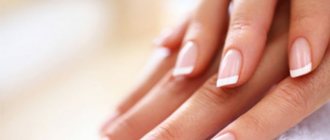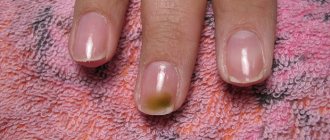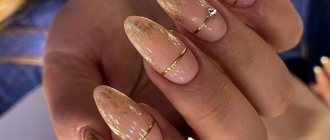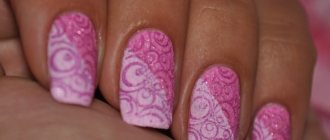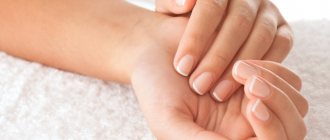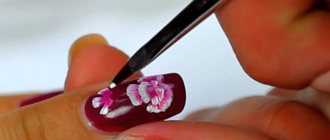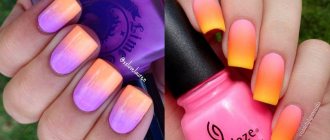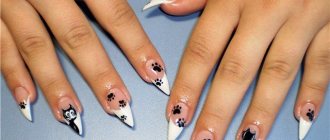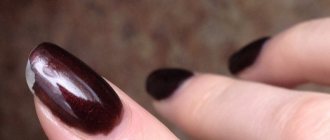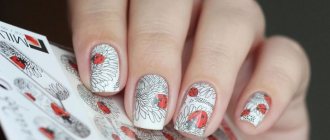Onychorrhexis (ICD code L 60.3) is a type of dystrophy of the nail plate in which it splits along the direction from the free edge to the growth zone. Occurs in women and men. Depending on the cause, onychorrhexis is observed only on one nail or on all of them at once. Cracks can be single or multiple, of different lengths and depths.
What causes?
The causes of onychorrhexis are divided into internal and external. When the body weakens, chronic pathologies, infections, the nail initially grows fragile. It cracks easily, delaminates, breaks off from the free edge. Due to impaired blood flow and chronic diseases, longitudinal splitting of the nail is often found in older people. The older the person, the higher the risks. Aging of the body is the most common reason.
Internal factors include:
- diabetes, thyrotoxicosis, cause metabolic disorders;
- atherosclerosis, lead to a decrease in the lumen of blood vessels, a decrease in blood flow, and the supply of nutrients;
- eczema, psoriasis, cause inflammation, disruption of the nail structure;
- autoimmune diseases (Raynaud's syndrome, vasculitis), damage the walls of blood vessels, nutrition of the matrix, reduce the strength of the resulting plate;
- lack of vitamins and minerals in the body due to malnutrition, eating disorders (anorexia, bulimia) or gastrointestinal diseases that interfere with the absorption of nutrients and change the chemical composition of the plate;
- fungal infection, provokes an inflammatory process, destroys the healthy structure of the nail;
- tumor diseases.
External factors can cause dystrophy:
- injuries received during a manicure or pedicure;
- household damage;
- working with cleaning agents and detergents without protective gloves;
- wearing shoes that don't fit;
- features of the profession: working at a computer with nails tapping on the keyboard, or playing the piano;
- continuous wearing of gel polish or artificial coverings;
- using acetone-based nail polish removers;
- habit of biting nails;
- frequent contact with water, alcohol, solvents, chemicals that dry out and damage the plate;
- Excessive length, improper cutting of nails.
In children, onychorrhexis is caused by trauma, decreased immunity, and previous infectious diseases.
What to do first
The formation of cracks may vary. Take into account its type in advance: if the free edge has been damaged, carefully cut it off with a file, moving it in one direction, but damage to the general part is dangerous due to the introduction of infection into the body due to the formation of an open wound, so be careful with it.
Follow the first aid technology for nails:
- Disinfect the affected area. To do this, use a cotton pad soaked in hydrogen peroxide. You cannot use alcohol-based antiseptics so as not to irritate the epidermis.
- Lubricate your fingers with cosmetic oil or rich cream.
- Cover the crack with adhesive tape.
- Consult your doctor.
Seeing a doctor if a serious crack forms for unknown reasons is mandatory, since emergency damage to the nail structure may imply the development of a serious disease in the body that needs attention.
In addition, the doctor will prescribe competent treatment that will help carefully restore the integrity of the nail, preventing dirt or infection from entering through the crack.
What are the symptoms?
The main sign is the presence of longitudinal cracks on the plate, running from the free edge to the center or base of the nail. They look like grooves or furrows. Depending on the cause, there may be one or several cracks, only on one finger or more. Onychorrhexis affects the fingernails and toenails, but is more common on the hands. On the feet, only the big toe is predominantly affected.
What onychorrhexis looks like is shown in the photo of the nail below:
In addition to longitudinal cracks, thinning of the plate, a change in color to yellowish or grayish, and an uneven laminated free edge are also possible. Due to increased fragility, longitudinal splitting is often combined with transverse splitting, which is called onychoschisis.
Vertical grooves on the nails, reminiscent of onychorrhexis, are characteristic of trachyonychia. And their treatment principles are similar. This is a type of onychodystrophy in which the nails become dull, rough, and covered with grooves and scales.
How to stop a crack from spreading
Repairing a crack will not heal it, so fixing the damage is not enough. It is important to get rid of the root cause of nail breakage.
And in order to patch a crack , avoid pain and prevent the nail from breaking, you need to:
Cracked nail repair process
- sand the crack with a buff or file (it is important to choose a file with fine abrasiveness);
- Using a manicure brush, carefully apply a little glue to the crack area and wait for it to dry;
- attach a piece of silk or similar fabric, apply another layer of glue ;
- remove excess fabric edges , apply a third layer of glue ;
- make sure that the fabric is attached tightly, and then polish the repair area with a buff or file;
- cover cosmetic varnish .
Instead of fabric, you can use paper or a napkin , but then the patch will peel off faster. You can fix the crack with a bactericidal plaster . To repair a longitudinal crack, it is better to go to a nail salon, since the damage quickly spreads as the nail grows and silk will not always be able to hold it.
Longitudinal cracks spread quickly, are difficult to repair and cause severe pain, so in such cases, professionals use a special gel or biogel, which, due to its natural nature, helps to heal the crack faster.
Watch the video tutorial for the process of repairing a nail with silk:
Diagnostics
If you find a plate splitting, contact a podiatrist or dermatologist to prevent the condition from getting worse. If left untreated, the crack will grow and reach the free edge. It will divide the nail into two halves and cause detachment from the bed. In addition, violation of the integrity of the plate opens access to pathogenic pathogens and often leads to bacterial or fungal infectious complications.
The specialist will examine the structure of the plate, assess the severity of the damage, suggest how to treat onychorrhexis of the fingernails or toenails, and how to improve their appearance.
To find out the cause, he will ask the patient about chronic diseases and prescribe additional examinations:
- examination of a nail scraping for fungus;
- general blood test, sugar test;
- consultation with an endocrinologist, gastroenterologist, vascular surgeon;
- microscopic examination;
- examination with a dermatoscope at 10x magnification.
Prevention
To avoid such problems, you should follow some simple rules and tips:
- Always protect your hands from chemicals and water when cleaning;
- Moisturize your hands every time after contact with water;
- Use special nail oils to strengthen and nourish them;
- Periodically take baths with sea salt, they perfectly strengthen your nails;
- Don't forget to protect your hands during the cold season;
- Try to diversify your diet and eat foods that contain nutrients for your nails.
It’s good when the problem is fixed at home and there is a visible result of the procedures. But it happens when the body does not cooperate, and the situation worsens. In this case, you should not refrain from seeking professional help. The doctor will be able to determine the exact cause of the problem and prescribe treatment.
Always pay close attention to your hands and nails. After all, they give us signals and hints about what needs to be corrected so that the body works well and is healthy. Try not to make the problem worse or delay treatment. After all, cracked nails will attract attention, so start treatment immediately.
Liked? Share with your friends!
How to treat?
To treat onychorrhexis, an integrated approach is used, aimed at eliminating the cause, normalizing metabolic processes, and strengthening the structure of the nails. If these conditions are met, treatment gives a good result. True, it takes up to six months, since the nail plate grows slowly, on average by 1 mm per week. The matrix where nails are formed is hidden under the skin of the lower roller, at a distance of 4 mm from the cuticle. It will take 4 weeks just to improve his condition, and to change the plate on his fingers it will take 4 to 6 months.
Treatment is selected depending on the severity of the injuries and the person’s health status. When identifying concomitant pathologies that cause longitudinal clefting, attention is paid to their treatment.
To strengthen nails the following is prescribed:
- massage;
- vitamins, amino acids, minerals;
- medicinal baths;
- drugs to strengthen the walls of blood vessels and improve blood circulation in the extremities;
- physiotherapy (paraffin therapy, ozokerite, mud masks).
Traditional methods and remedies for the treatment of onychorrhexis of nails include masks or baths with natural oils, oil solutions of vitamins, gelatin, as well as moisturizing and nourishing creams. They help strengthen nails and accelerate regeneration processes. But it is better to discuss the safety of their use with your doctor.
In case of deep, long cracks, the plate is reinforced with artificial materials to stabilize it.
The mechanism of formation of emptiness under the nails on the toes and fingers.
Causes of onycholysis on the legs:
- Long toenails.
Often, when covering their toenails with gel polish, girls forget to file the length every 2-3 weeks. Due to the excessive length, there is a load on the nail plate from above and from the end.
- The shoes are the wrong size.
Shoes that are the same length as your foot or shorter put pressure on your big toe. The foot lengthens by 1 cm while walking, which is almost imperceptible to a person. But regular load from such shoes will lead to emptiness under the nail.
- The risk of nail separation from the nail bed increases in dress shoe wearers with a narrow forefoot.
When wearing such shoes, the big toe is severely compressed, the blood circulation of the matrix is disrupted and a void appears under the nail.
Care and prevention
When treating onychorrhexis, as well as for its prevention in the future, it is important to properly care for the nails, skin of the hands and feet.
What rules must be followed?
- Wash dishes and use any cleaning agents or detergents only with gloves.
- For manicure, choose high-quality varnishes with a harmless composition; do not use removers containing acetone to remove nail polish.
- Avoid frequent contact with water.
- When treating onychorrhexis, it is not recommended to do a manicure or apply any coatings to the nails other than those prescribed by the doctor. In the future, take breaks from wearing gel polish and artificial nails.
- Take care of your drinking regime and a nutritious diet, including fruits, vegetables, and low-fat protein foods.
- Do not grow your nails too long; periodically get medical manicures and pedicures at podiatry centers.
- Massage your hands and feet daily, moisturize the skin on your arms and legs with nourishing creams.
As a rule, onychorrhexis does not cause pain or inflammation, but you still need to go to a podiatrist with this problem. The specialist will prescribe the correct treatment, which will speed up the recovery of the nail and prevent the development of complications. He will also tell you about the rules of care at home so that splitting or splitting of nails no longer bothers you.
17 1
Prevention of cracked nails
To prevent illness:
- Follow the rules of hygiene, wash your hands at least 4-5 times a day.
- Moisturize your skin after using cleansers.
- Protect your hands from exposure to chemicals - wear protective gloves when doing housework, washing dishes, or gardening.
- Consume enough water - at least 1.5 liters per day.
- Cover your nails with clear polish. A base coat is important to ensure good adhesion to the nail plate and prevent chipping.
- Be careful when removing cuticles. There is a possibility of infection or fungus.
- Don't bite your nails.
- Wear gloves in cold weather. Winter's dry air penetrates the layers, making nails so fragile that even the slightest impact can cause them to break.
To avoid the disease, it is recommended to adhere to the rules of prevention, otherwise, do not delay treatment.
